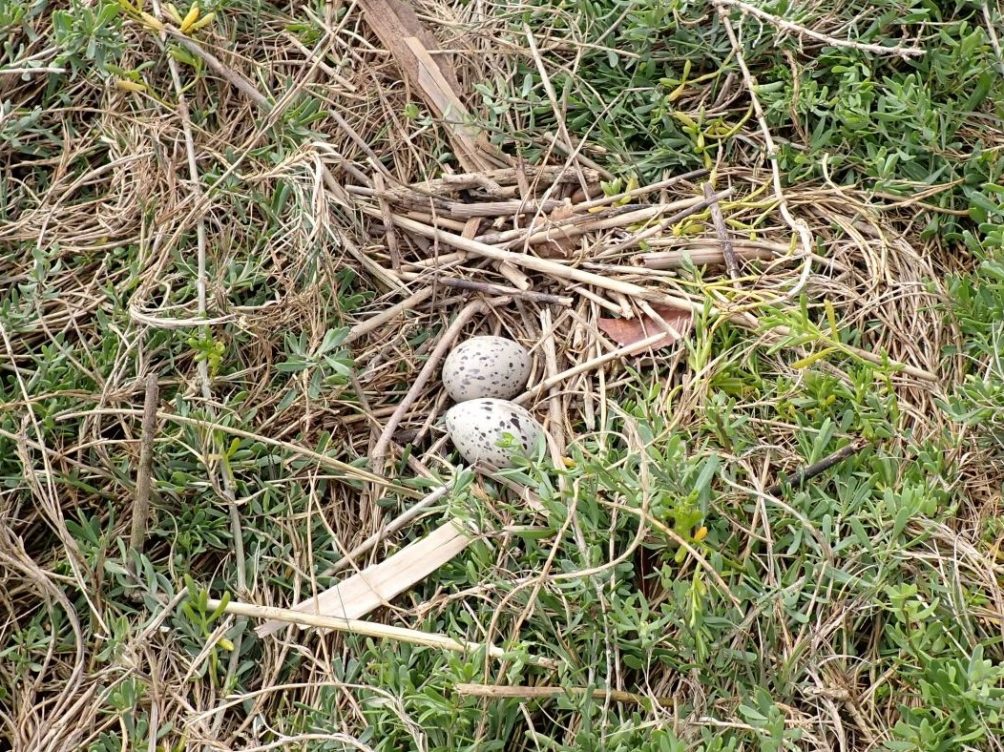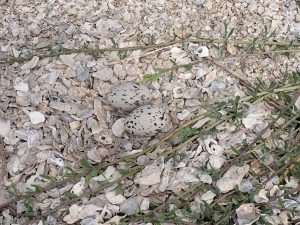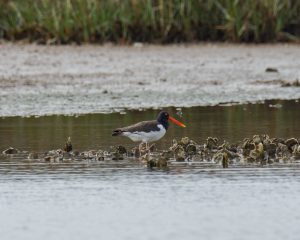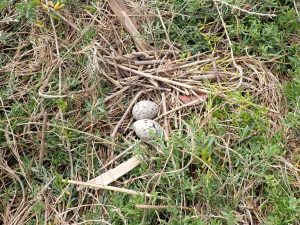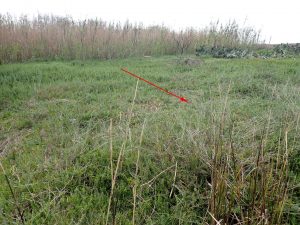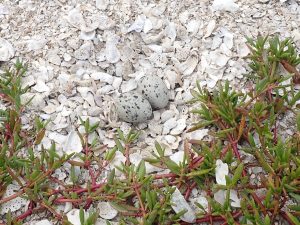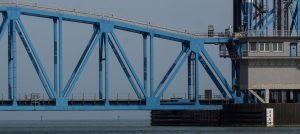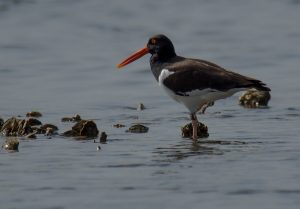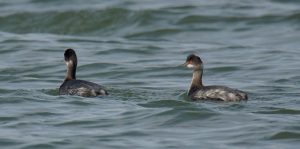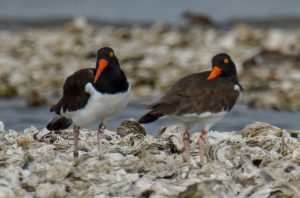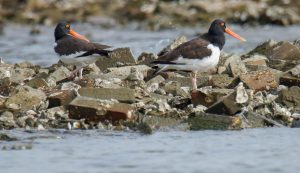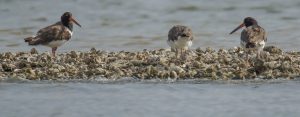By Susan Heath
I had to move my day with oystercatchers from Thursday to Wednesday because of the impending Arctic blast. That wouldn’t have been a big deal except I also had to go monitor Loggerhead Shrikes on Wednesday morning. The shrikes only take a couple of hours though so I figured Alan and I could make a mad dash out to West Galveston Bay late morning after I was done. I knew it would be a long day but such is the life of a field biologist. When I pulled out of GCBO with the boat at 9:30, it was overcast, foggy and threatening rain. Eak! The weather channel forecast said it was going to clear though and I hoped they were right. When I arrived at the boat ramp, the fog was so thick you could not see Tiki Island. Drat! But magically by the time we got the boat in the water and started heading out, we could see the houses clearly! Perfect timing.
We headed out to Jones Bay and found an unbanded pair on what used to be P3’s island. I suspect this is the same pair that was on one of the islands by the boat ramp the last time we were out. We shall see if they stick around. CA & Y2 were standing on the exact same reef they were standing on when we checked on them two weeks ago. Hum. This sort of non-action is not going to fare well! We headed over to FR’s territory and he and the missus flew out from behind a shell berm and went way down the island to a far reef. I suppose they were trying to decoy us away but of course it didn’t work because we already know their secret! I checked their nest and found it now has two eggs. Only two eggs? It worked for them last year so I guess they’re going with that strategy again.
We headed up Marker 52 and found W5 & JC also on the exact same reef they were on last time. Tsk, tsk. These birds just don’t listen to me when I tell them to get going early. JJ & JC were on a far reef that was too hard to get to so we went to check on YM & JH on North Deer. And… I’m sensing a theme, they were also on the same reef they were on the last time we checked. When we started to make our way over to check on J6 & UF, something got JJ & P4 riled up and they flew from their reef over to their nesting territory and so we were able to verify their bands.
I had been looking forward to checking on J6 & UF because I suspected they would have a nest but when we got to their island, they weren’t there. If you followed along last year, you’ll remember that this pair nests on a very small and very low island where they have had many eggs and chicks washed away by high tides over the years. Last year they somehow managed to get their small chicks to swim from the small island to a larger island (we weren’t sure which one) during a high tide and we didn’t realize the chicks had survived until they were fledged.
I was at first perplexed that they weren’t on the island and there were no eggs but then the light bulb went off. Maybe they laid their nest where they took the chicks last year! It could only be one of two places, the backside of Marker 52 or behind the breakwater that surrounds North Deer. We were closer to the backside of Marker 52 so we headed over that way. This area is full of reefs that aren’t navigable and the habitat on the island is marsh grass and other thick ground covering. Not suitable nesting habitat for oystercatchers at all and as far as I know, no pair has ever nested there. But when we got closer to the reefs on the backside of the island this is what we found.
UF was standing on a reef near the shore alone. This time of year when you see one member of a known pair of oystercatchers alone, it is a sure sign that the other member of the pair is on a nest somewhere. Ah ha! We got pretty close to her and she tried to ignore us but she also didn’t leave. Ok UF. I know something is up! The mud was too thick to get off the boat and walk up to the island from there so we had to motor our way out of the reefs and move to another reef that butted up to the island so I could walk over. Just as I got to the island I heard Alan yell from the boat and I looked out to see that J6 had suddenly joined UF. Alan said he’d flown out from behind the spartina along the water’s edge. Unh hunh. I’m on to you buddy! I gingerly walked through the vegetation until I found this!
Wow. That is so not where you would expect to find an oystercatcher nest.
But hey, save yourself the harrowing chick swim and start out where you succeeded last year. I’d say that’s a good call. Except this area will be covered with nesting Brown Pelicans pretty soon. I hope the eggs hatch before that happens. If so, they’ll probably have a good chance at success. Finding that nest made my day!
We checked on the two pairs behind the reefs at North Deer. C1A & unbanded’s territory was covered with Great Blue Herons standing around staging for nesting season and there was no sign of the oystercatchers. Probably not a wise choice to plop down some eggs there until the herons move out. One of E6A & unbanded was out on a reef and I saw the other one up in the veg so ding, ding, ding that means there’s a nest! I trudged over there and sure enough two eggs.
By this time the fog was completely gone and it had turned into a beautiful day. There was blue sky and not much wind and it was 70 degrees! This is the kind of day you dream of when you’re on the water. We don’t get many of them and I was very glad I’d squished my two field days together to make it happen. We decided we’d better head up to Swan Lake and get that done in case the wind picked up later. The railroad bridge had been open all morning and as soon as we headed that way, it started going down! I swear that thing is timed to our movements.
Fortunately the tide was so low that we could go under easily. We didn’t find any of the pairs along the Galveston shoreline so we headed into Swan Lake. K7 was out on a reef and there was no sign of his mate.
Scroll back up and remind yourself what I said about seeing this situation during this time of year. But in this case I found no nest. K7 was acting very sketchy though and calling out alarm calls to his mate who I eventually located on the other part of the island. I never did find a nest and it occurred to me that they might have chicks already but I didn’t find any of those either. Of all the pairs we monitor though, this one is the trickiest and perhaps the smartest. They are VERY good at hiding chicks. We’ll just have to keep watching them.
We encountered three Eared Grebes in Swan Lake and their red eyes were just amazing. Alan snapped a photo.
The other two pairs up there were both out feeding on reefs so we headed back to West Galveston Bay.
Next up Struve Luci which is fun because there are two nests there! We stopped out in the bay so we could spy on them from afar. HM & X7 were up on their rock wall checking things out. Looks like they will nest there again this year since their area on the island is so eroded now. We couldn’t see what was happening with the other pairs so we moved in and I went to check things out. 12 & unbanded still have three eggs and it appears they have pushed their neighbors (an unbanded pair) farther down the island away from them. 12’s territory has become eroded too and as it has, he and his wife have moved closer and closer to the unbanded pair’s territory. This year 12’s nest is basically in what used to be the other pairs’ area. I figured there would be some fireworks. Seems 12 & unbanded are as badass as ever because the unbanded pair was way at the other end of their territory staying out of the way! LT & JA now have three eggs too but they also had a visitor. W4W was attempting to hang out with them much to their distress. Here is JA doing her best to “ignore” the intruder while also keeping an eye on it.
W4W is P3’s last chick so I have a soft spot in my heart for it. It’s three years old now so on the cusp of trying to find its own breeding territory. It didn’t seem like it was being too aggressive about it but you never know. Last year JX caused L9 & unbanded’s nest to fail because he was repeatedly harassing L9 trying to take his place. And speaking of L9 & unbanded, I searched their territory but they don’t have a nest yet.
On to Jigsaw where we found both pairs but no nests. It was getting late and I was getting tired but I was still on a bit of a high from figuring out the mystery of where J6 & UF took their chicks last year so my head was still in the game! We checked along the Galveston shoreline and found 16 & unbanded hanging out on the brick jetty again.
No sign of JX & YK that were there the last time we were out. We moved on to South Deer and found Y7 & unbanded and A5A & unbanded out on reefs but no other oystercatchers. The almost total abandonment of South Deer by oystercatchers continues to distress me. Another mystery that I think I think I know the answer too but I’m not entirely sure.
On Confederate Reef we found a gang of seven young birds that are probably all chicks from last year. You can tell they are young because their bills still have a bit of black.
Five of them were banded and included: U6W and U7Y (two of 12 & unbanded’s three chicks in 2020), W6Y (one of LR & unbanded’s three chicks in 2020), U7X (K7 & unbanded’s 2020 chick) and W9W, a chick that was hanging out on the dike and was easy to catch while we were trying for entangled birds. We don’t know who its parents are but I’m happy to see that it found some friends and moved off the dike.
At Gangs Bayou we found A1A on the breakwater and his mate on a nearby reef. A4A & unbanded were also on a reef so no nests there yet. We headed across the bay and counted six Brown Boobies on the shell marker signs. At Greens Cut we found a single unbanded bird and no sign of F9A. Hum. No nest again! You guys are ruining my track record. We looked all around but found no nest and no sign of F9A. It’s possible he was on a nest on the big island near there along the GIWW but it was so late, I didn’t want to take the time to go look. If one of them is still AWOL next time, I will.
We checked some birds along the GIWW on our way back to the boat ramp and found W1W. That’s a bird banded as a chick in 2018 that hasn’t set up a breeding territory yet. It appeared to be paired with an unbanded bird though so we’ll see what happens.
So now we wait and see if the nests can survive temperatures in the teens through this cold spell. Fingers crossed! It’s a tough life for these birds. Think about them sitting on those eggs in a cold north wind while you’re snuggled in your bed at night. Brrrrr!
If you like oystercatchers and you want to support this project, you can make a donation (thank you!) on our website here. And how could anyone not like oystercatchers! You can also adopt a pair of oystercatchers to support this project if you’d like. If you adopt a pair, you will receive an adoption certificate for your birds and I will update you monthly on their progress throughout the breeding season. All adoption funds will be used to fund our work for the oystercatchers.
Current Stats for upper Texas coast from Dickinson Bay to East Matagorda Bay: 5 nests being incubated, 0 failed nests, 0 nests with unfledged chicks, 0 nest with undetermined status, 0 chicks fledged
Note: All trapping and banding for this project is in accordance with federal and state permits issued to Susan Heath, GCBO Director of Conservation Research. Bird handling by volunteers is only permitted in the presence of Susan Heath and volunteers are trained in proper bird handling techniques.

